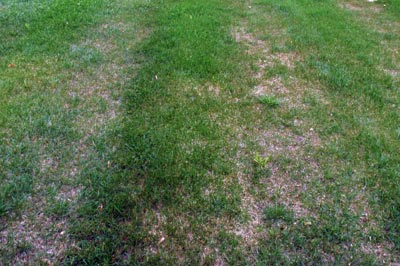Soil compaction and what to do about it
Fall is an excellent time to amend vegetable garden soils by adding organic matter or cover crops to help alleviate soil compaction issues during the growing season.

Gardeners may want to consider whether they’ve been seeing these signs of soil compaction. The soil seems difficult to dig or till. Or the plants are not growing as well as they should and seem to have an inadequate root system. Water tends to collect and puddle after a heavy rain and is slow to drain. Any of these may be due to compacted soils.
Soil compaction occurs when particles are packed too closely together. Compaction is more common in heavier soils like clay and loam; however, it can occur on sandy soils as well, especially if heavy equipment is used on the lawn or garden. Compaction can be compounded by events that occurred to the soil over several years.
About half of a healthy soil is made up of mineral particles: sand, silt and clay plus organic matter. The remaining half consists of pore space which creates room for air and water to move around the mineral particles and is required to have a healthy environment where plant roots, beneficial microorganisms and earthworms can breakdown plant residue into organic matter. Compaction occurs when pore spaces are reduced to the point that air and water cannot move freely and plant roots cannot grow easily into the surrounding soil. The soil could remain overly wet longer than is healthy for the plants growing there.
There are four factors that contribute to compacted soil: over-tilling soil, working soil when it is too wet, mixing sand into clay soils in an attempt to loosen soil, and soil compression because of weight. One of the most frequent causes of compaction is from over-tilling soil. This occurs when an area is tilled multiple times and soil aggregates are broken down into single particles. This leads to fewer pore spaces. After a rain, water does not move as easily through the soil and a mini-pond is created when the soil finally dries, resembling an alligator’s skin. This linear pattern of cracked soil does not let air or water in.
Working the soil when it is too wet is another frequent form of compaction. If one can take a handful of soil and make a ball that will not fall apart when gently poked, the soil is too wet to be tilled. The key is to wait until the soil is drier and crumbles. Working soil when it is too wet often occurs in the spring when gardeners are anxious to get started.
Another form of compaction is mixing sand into clay soils to try to loosen the soil. This creates the opposite of the desired effect and the soil becomes like concrete. The best method for improving soil tilth is to add organic matter such as compost, peat moss or leaf mold.
A fourth form of soil compaction occurs when vehicles often park or drive on a lawn, when construction equipment has frequented an area, or when people repeatedly walk over an area creating a path. Such areas may include where vehicles are parked on the grass, riding lawn mower tires running in the same place over a long period of time, areas where dogs run constantly or the shortest route to the bus stop.

Dead areas indicate where mower tires repeatedly drove over the lawn, compacting the soil. The path between the tires is robust. Photo by Kevin Frank, MSU.
Once one realizes they have areas with soil compaction problems, there are several things one can do. Resist the urge to routinely roto-till or cultivate the garden. Instead, consider adding organic matter by using mulch or compost over the top of a flower bed, or hand-spade it into the top 3 to 62 inches of the soil. For vegetable gardens, put 2 inches of compost on the soil surface and till in and repeat for a total of 4 inches in a growing season. Having a goal of 5 to 15 percent organic matter would be advantageous.
If a roto-tiller is used, be careful not to repeatedly go over areas that have already been cultivated. Using organic matter like straw or chopped leaves in a vegetable garden that can be mowed and turned into the soil in the spring or fall will add more organic matter. Soils should be tested every three years for nutrients, soil pH and percentage of organic matter. The Michigan State University Extension Soil Test Kit Self-Mailer is available for this purpose and may be obtained from your county MSU Extension office or online at the MSU Extension Bookstore for $26. You will also receive a recommendation for nutrients to improve the garden.
On larger vegetable garden plots, cover crops may be grown to help alleviate compaction. Fall cover crops may include annual ryegrass, cereal (winter) rye, winter wheat, hairy vetch, oilseed radish or some combination thereof.
None of these fixes for soil compaction are quick and easy. An awareness of how soils are compacted, how to prevent compaction and how to improve them is a lifetime commitment to having better soil and better crops.
See the Smart Gardening tip sheet “What to do about compacted soil” for more information.
For more information from Michigan State University Extension on Smart Gardening topics and factsheets, visit the Gardening in Michigan website.



 Print
Print Email
Email


